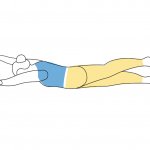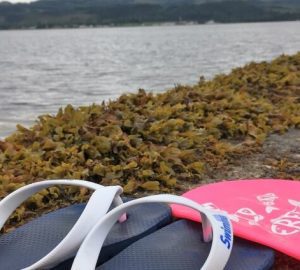Matt Baker – Henley to Marlow solo
Two months after the official Henley Swim Bridge to Bridge event, I swam the same 14.1km course between the landmark bridges of Henley and Marlow in a solo record attempt. My writing here is undertaken with just a touch of guilt; my efforts during the swim were to be focused on beating the existing record holder and Henley Swim co-founder Tom Kean, who in turn took the record from fellow founder Jeremy Laming last autumn.
I didn’t undertake this challenge without some familiarity. The Bridge to Bridge course is certainly no stranger to me, and as the current Captain of Henley Open Water Swimming Club, it’s a stretch of the Thames that is home to our normal training grounds. I was also lucky enough to be one of those swimmers that had completed the course before it became an official event, and also took part in the inaugural Henley Swim sanctioned running in 2011 where I swam as the pace-setter for the gold pod. This year however I couldn’t take part due to family commitments, but did manage to come down in time to watch one of my training partners, Mark Billyard, swim under Marlow Bridge well clear of the rest of the field, including a number of highly notable athletes; Greg Whyte, Chrissie Wellington and Toby Garbett to name just a few, and in a time of just 2 hours 50 minutes. The official recorded times can’t show the full extent of this achievement, since it is run as a non-competitive sportive and the finish times are rounded within the pods, but I had enough time to walk down from the bridge, all the way round Marlow Rowing Club and up to the waters edge before Greg swam under the bridge as the second finisher.
Why do I bother to tell you this? Last year I was one of the first under the bridge in 3 hours and 20, so Mark’s time was a full 30 minutes faster. That’s quite some increase in pace! From previous solo efforts, we’re all well aware that swimming alone gives you the chance to shave minutes off the time by not waiting at the feed station for your pod to assemble and get ready for the next leg. But it’s also compromised by removing the option to draft behind other swimmers, and by the need to manage your feeding and rest (or not resting) strategy during the swim. I knew a sub 3 hour swim was possible based on my efforts the previous year – we took our time at the feed stations, and the pods were much larger than those adopted this year so the impact of slower swimmers dictated the overall pace to a higher degree. But even so, and even allowing for the faster stream conditions this year, that time of 2:50 was nothing short of an outstanding result. It was also the catalyst to make me want to have a crack at a solo effort.
So two months later, with stream conditions that had eased off to more normal levels, and with my support team led by Tom Kean, to whom I am hugely grateful for the efforts made to set up and sanction my attempt, we arrived at Henley’s Leander Club on the morning of the 16th September in the pitch black pre-dawn ready for a 5:30am start. Knowing the sun would come up, low in the sky and directly ahead of me, I chose a polarised tinted goggle counting on the value they’d deliver later in the swim. Upon lowering them ready to get in for a quick warm up, I found myself in a totally black world. All I could see were a few bank-side illuminations from Phyllis Court, and the lights from my safety team’s head torches. Not much to go on in one of the widest stretches of the upper Thames. No time to worry about that though, my swim was on, and it was time to get going. It would be light by the end of the first stretch anyway.
The first 4km is a long stretch, with a few obvious landmarks like Upper Thames Rowing Club, Temple Island and the Henley Management College that all help to position the distance covered. It’s familiar ground from my days rowing for Leander, but the experience in the water, in pitch black surroundings, completely alone is very different and quite humbling. That morning was also the day of Challenge Henley, and as I cleared Temple Island the tannoy system for the event could be heard addressing the first athletes that would soon take to the water for their Ironman distance event. Yet more surreal impressions as floodlights now cast some illumination across the river, and safety boats patrolled the water making an undulating wash to swim through. I’ve always found this stretch one of the longest, perhaps because of my familiarity rowing it where the distance is covered so much faster – what’s just a few strokes rowing or sculling can seem like forever swimming. But before I knew it, that stretch was done, and I was climbing out to run around the lock and get back in for the longest single stretch all the way to Hurley. During the official running, this stretch has a feed station half way at Medmenham, but my plan was to keep swimming through this section only feeding again after the next few kilometres when the next lock had to be navigated.
This long middle stint is probably my favourite part. You can build a good strong rhythm, there are no other boats to worry about, and it’s familiar water for swimming since we use these parts of the Thames most frequently for training sessions. It’s also home to the one part of the course that I don’t like – the backwater section at Hurley through the Islands. I don’t know why, but I’ve never liked swimming out of the main channels – I guess because it’s that much shallower with lots of weed. Still, it is part of the course, and an excuse to up the pace, get the focus back and press on for the last couple of kilometres before I can top up fluids and take on a gel.
The lock at Medmenham brings you out for one of the more interesting sections – we rarely swim this part so it always feels like a little adventure linking through to Temple lock another couple of kilometres downstream. It’s also around here that the distance starts to have a physiological impact. Most of my swimming events are between 1500m and 3,000m, so suddenly upping the distance to over 14km, even stream assisted, isn’t exactly within my comfort zone. Even a regular 10km swimmer would probably find themselves challenged in the last 2km as they go beyond their normal ‘marathon’ distance. To give a rowing analogy, it’s much like Henley Royal Regatta, where the upstream course just over 2.1km in length adds a small but very challenging extra few metres to the normal 2000m still water race distance. It catches many rowers out, and in the same way, the last 2km of the Bridge to Bridge is something that always stretches the swimmer’s ability.
And this attempt was no different. Getting out at Temple, and back in for the final stretch down to Marlow stretch, I could feel the fatigue in my shoulders and arms, and 2km swimming is still a long way. By now the rowers are also out in force, so sighting becomes more important to keep well tucked into the bank and out of their way. I’m conscious this is keeping my out of the stream, and the competitive part of me finds this frustrating, but since it’s an unavoidable reality, I just get on with it and try to focus on technique and rhythm to get through the last chunk. It’s soon over, and I cross the line denoted by the famous Marlow suspension bridge. There’s a strange disconnect here. The only people around are the rowers and my safety team. No one beyond my team has a clue what I’ve just done, so it’s a strangely anti-climatic experience compared to most events, but that’s not what it’s about – I did this for the personal challenge and satisfaction it brings, and in this regard it delivers like no other swim. Does it matter that there wasn’t a welcoming committee and a big banner? Not a jot. Should you sign up for a solo attempt? Absolutely.
The swim took me 2 hours, 45 minutes and 41 seconds.
That’ll be a new record, at least until someone far more capable than me has a go. Be nice and give it at least a year before you do…
Matt Baker
Captain, Henley Open Water Swimming Club







